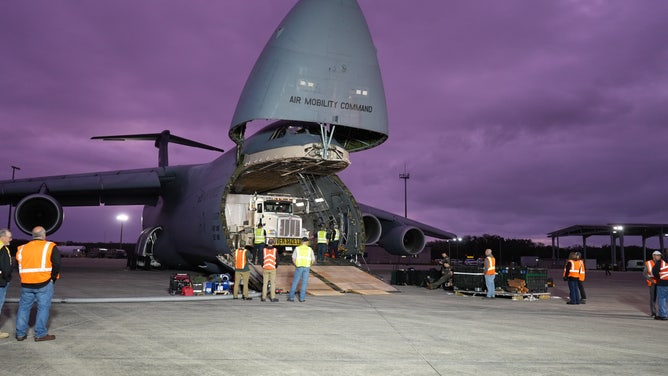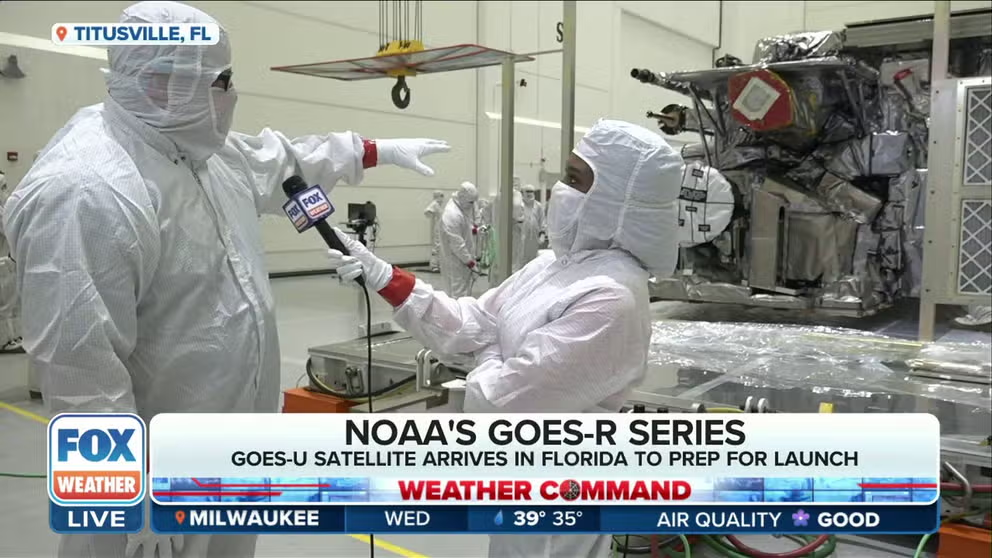NOAA’s newest GOES satellite launching during busy severe weather season, space weather
NOAA’s GOES-U satellite is the final GOES-R-series satellite and includes a compact coronagraph that will continuously observe the Sun’s outer atmosphere, improving space weather forecasting by detecting coronal mass ejections. SpaceX is scheduled to launch the GOES-U satellite on June 25 from Florida.
Final GOES-R weather satellite arrives at Kennedy Space Center
NOAA's next weather satellite, and the last of the GOES-R series, arrived in Florida ahead of liftoff. FOX Weather's Brandy Campbell is just outside the Astrotech cleanroom where the GOES-U satellite is being prepared to launch.
NOAA's next forecasting tool is ready to liftoff amid an already active season for severe weather and a busy time for space weather producing Northern Lights as far south as the Florida launch site where the GOES-U satellite will blast off.
The fourth and final spacecraft that is part of NOAA's Geostationary Operational Environmental Satellites-R series is scheduled to launch on June 25 at 5:16 p.m. ET on a SpaceX Falcon Heavy rocket from NASA's Kennedy Space Center launchpad 39A in Florida.
While the R-series satellites were designed to be the same, technological improvements and lessons learned from the previous three spacecraft helped NOAA decide to make some changes to the last satellite designed to observe the Western Hemisphere.

The GOES-U satellite is unloaded from a C-5M Super Galaxy cargo transport plane at Kennedy Space Center's Launch and Landing Facility in Florida on Jan. 23, 2024. Photo: Brandy Campbell/FOX Weather
(FOX Weather)
Watching the Sun
The biggest change with GOES-U is the addition of the compact chronograph. This chronograph will continuously monitor the Sun's outer atmosphere, known as the corona, allowing NOAA forecasters to see where extreme space weather like solar flares and coronal mass ejections originate.
The timing of this new capability comes after solar storms in May produced the first G5 geomagnetic storm, the most extreme on NOAA's space weather scale, in 20 years. It produced the Aurora Borealis in the southern U.S. The recent extreme space weather is tied to active regions of sunspots as the Sun approaches the most active period in its 11-year cycle, known as the solar maximum.
MESMERIZING TIME-LAPSE VIDEOS SHOW NORTHERN LIGHTS DAZZLING SKYGAZERS AROUND THE WORLD

CALIFORNIA, USA - MAY 11: Northern Lights (Aurora Borealis) illuminate the sky of San Francisco North Bay as seen from China Camp Beach in San Rafael, California, United States on May 11, 2024. (Photo by Tayfun Coskun/Anadolu via Getty Images)
(Getty Images)
Elsayed Talaat, with NOAA’s Office of Space Weather Observations, said once in operation, the compact chronograph will provide imagery of coronal mass ejections (CME) within 30 minutes. This is an improvement compared to the current data from NASA's SOHO spacecraft nearing the end of its life, which can take up to 8 hours to deliver similar data.
"These types of observations are key to our long-range forecasts in space weather," Talaat said. "They give us 1 to 4 days worth of warning before they reach Earth here and cause geomagnetic storms and potential impacts on human life, critical technologies."
While space weather doesn't usually affect everyday life, it can impact the power grid, GPS and other spacecraft. The solar storms in May disrupted the navigation systems used by farmers in the U.S. attempting to plant crops.
Forecast information from NOAA's Space Weather Prediction Center can help power providers and satellite operators take steps to prevent outages.
Watching Earth
The daily weather affects everyone on Earth, and GOES data is vital to NOAA's National Weather Service forecasts.
According to Jordan Gerth, a meteorologist with NOAA's NWS Office of Observations, forecasters have been busy using current GOES satellite data in April and May with deadly severe weather outbreaks across the central, eastern and southern U.S.
Cleanup continues in Texas after deadliest tornado in Lone Star State since 2015
Recovery efforts are continuing in parts of Texas after the deadliest tornado in the Lone Star State since 2015. FOX Weather Correspondent Max Gorden has the latest from Sanger, Texas.
Gerth said the NWS confirmed more than 720 tornadoes in April and May, and "GOES has been with us every step of the way."
Like the three other R-series satellites, GOES-U will also have an advanced baseline imager or ABI, which is key for NWS to issue severe weather alerts.
"Meteorologists at our Storm Prediction Center are able to issue severe thunderstorm and tornado watches as soon as it becomes apparent that the cumulus clouds are expanding and growing vertically. As clouds grow, they cool, and the ABI is able to sense those subtle changes in cloud temperature.
Clouds that cool faster are more likely to become severe and cause dangerous weather such as hail, straight-line wind and tornadoes.
Before GOES-U can contribute to forecasting weather, it needs to reach space. In the next two weeks, teams in Florida are preparing to encapsulate the school-bus-sized spacecraft into the SpaceX Falcon Heavy rocket fairings.
After reaching orbit 22,236 miles above Earth's equator, the satellite will become GOES-19, acting as NOAA's GOES-East satellite.

